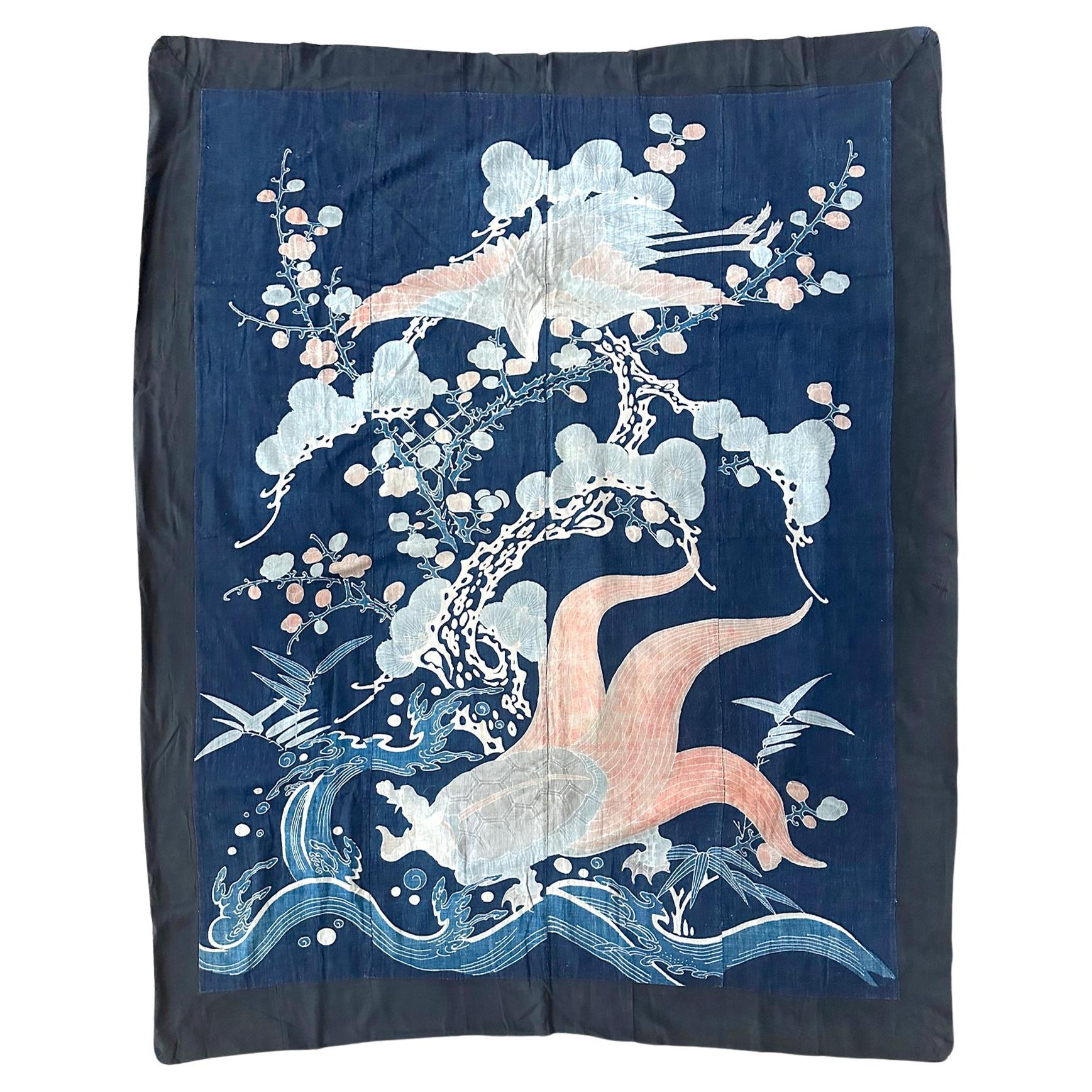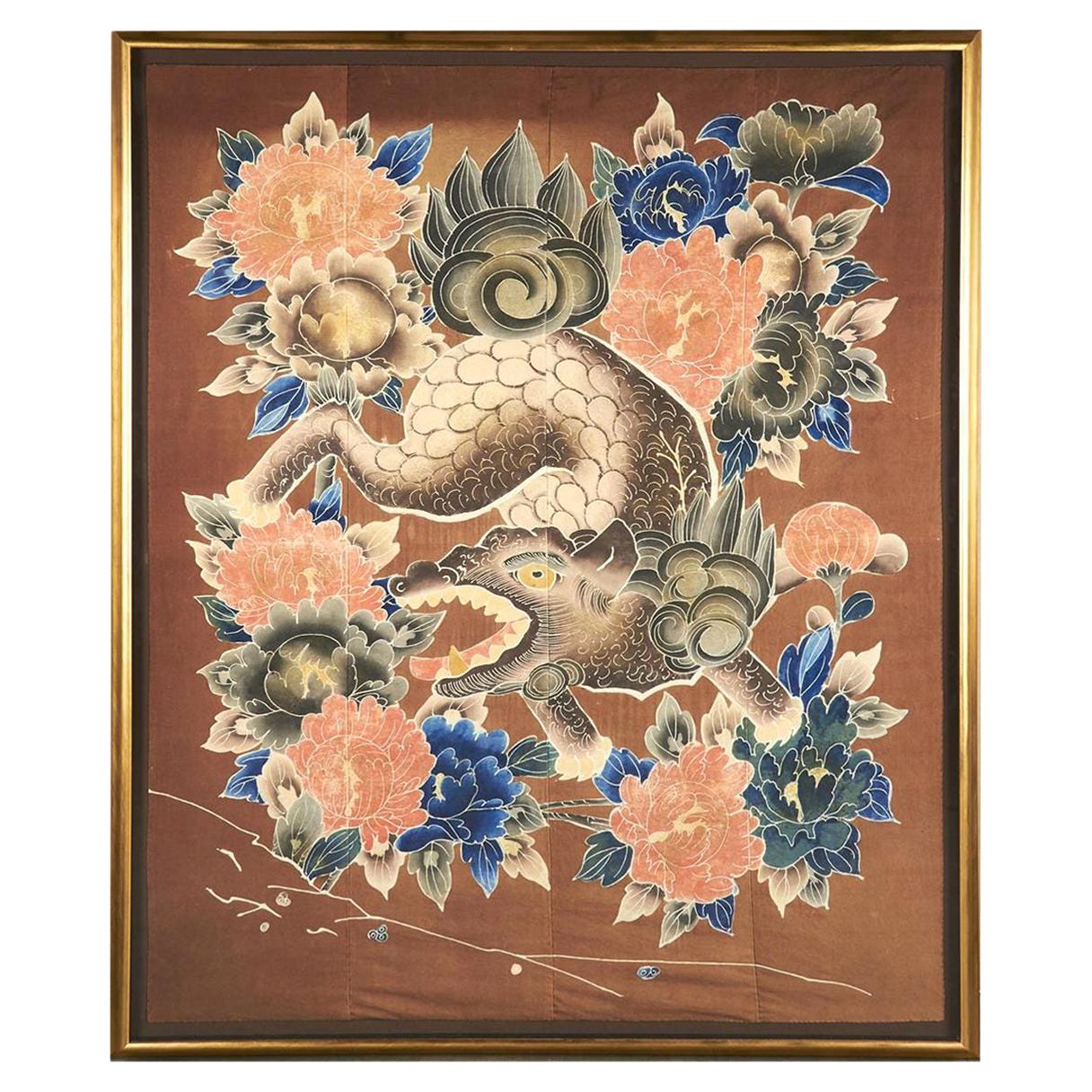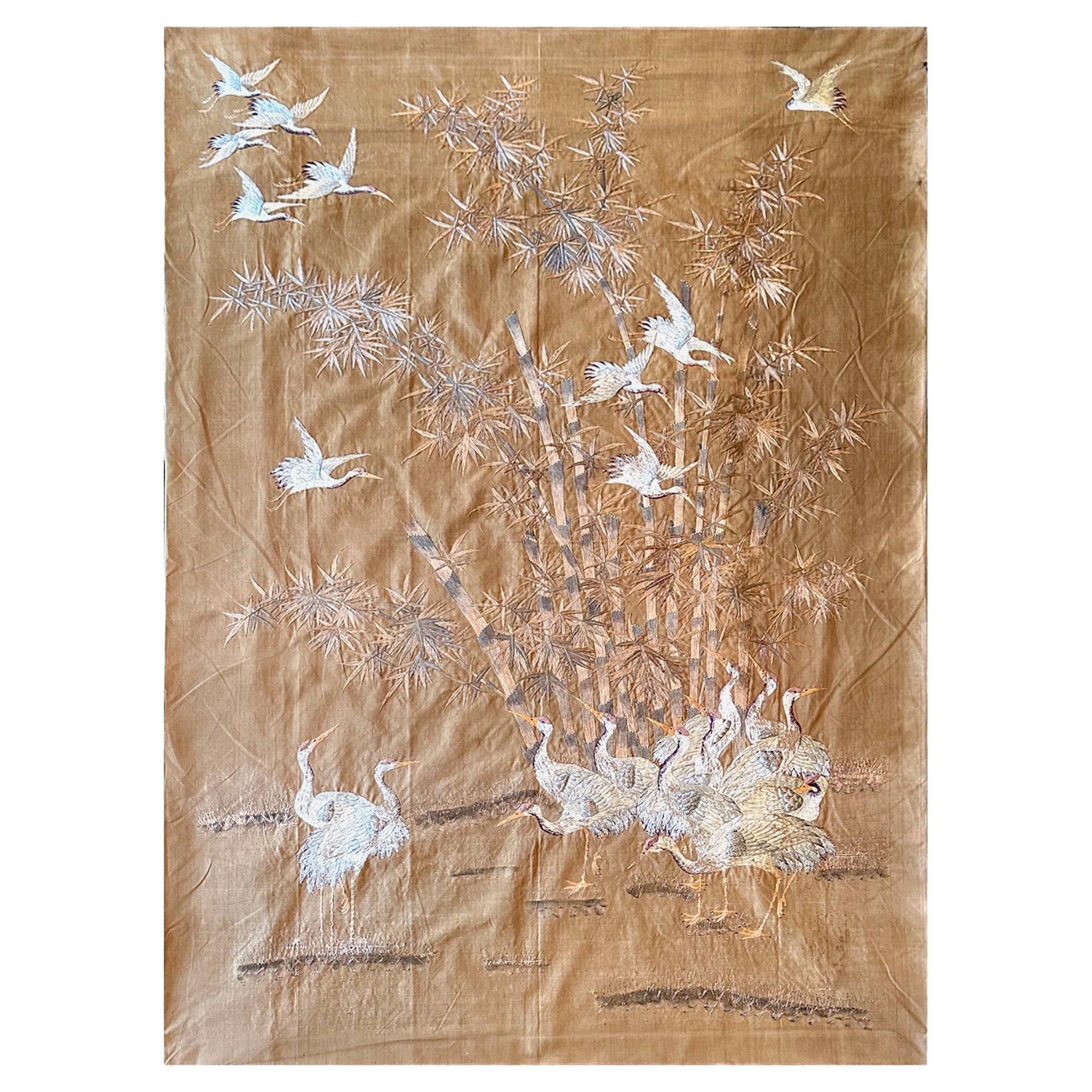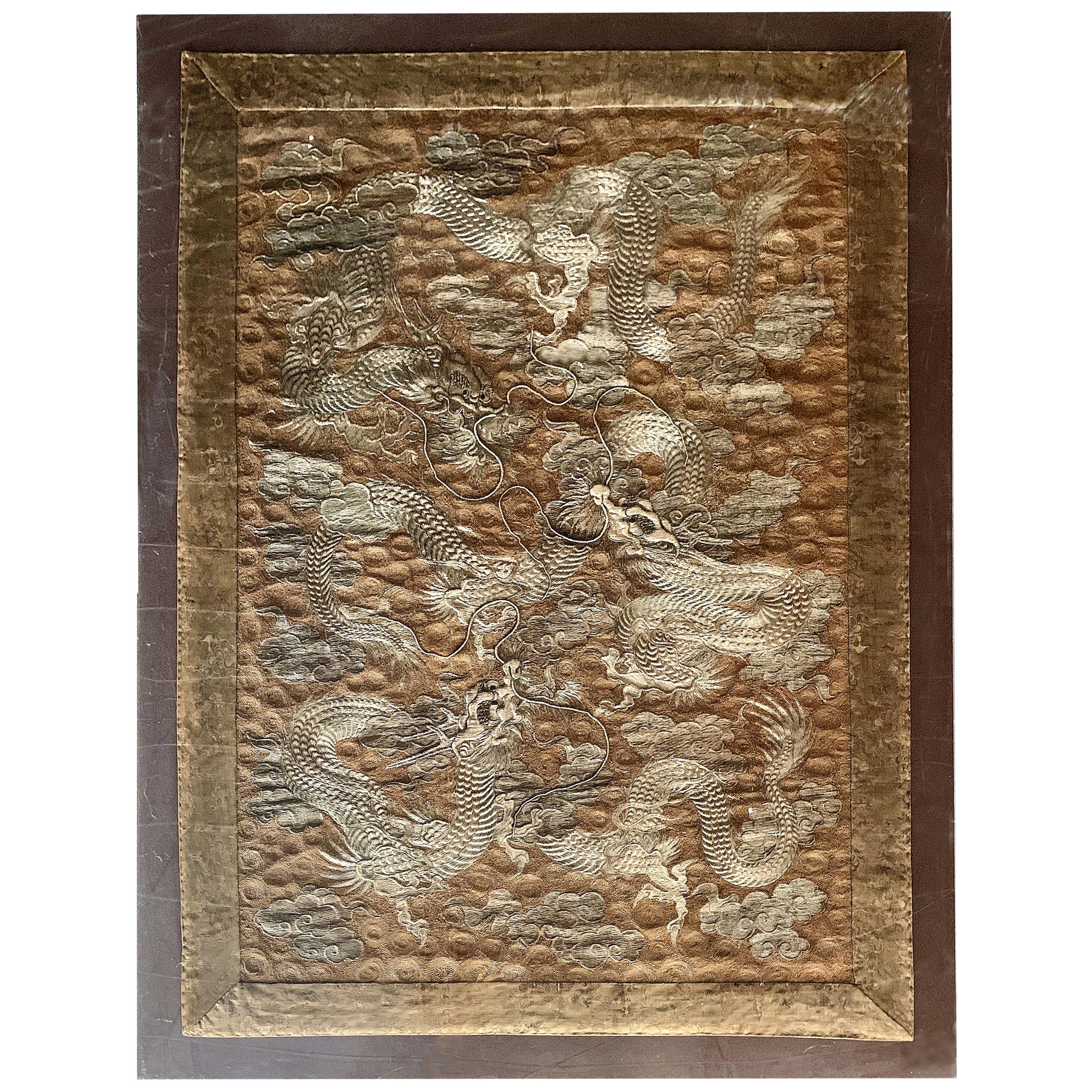Items Similar to Rare Large Japanese Velvet Yuzen-Birodo Wall Tapestry
Want more images or videos?
Request additional images or videos from the seller
1 of 21
Rare Large Japanese Velvet Yuzen-Birodo Wall Tapestry
About the Item
A large Japanese wall-hanging tapestry made from resistant dye painted cut and uncut velvet (the technique is known as yūzen birodo in Japanese). The tapestry is dated to late Meiji period (circa 1900-1920s) and likely a piece made for exposition in the west based on the size and subject manner. The romantic landscape depicts a wooded lake scenery with wooden sail boats, a lone fisherman and Mount Fuji in the misty distance. The location is one of the five lakes (Fujigoko) surrounding the Mount Fuji (possibly lake Kawaguchiko or Shojiko based on the viewpoint.) The iconic Japanese scene was created in the style of western painting with a strong sense of dimension, which was popular at the turn of 20th century when Japanese traditional art enjoyed an unprecedented exchange with the West. The original woven silk boarder and back remain as well as the loop on the back for displaying.
Image size is 57" h x 81.5"w.
The invention of Yuzen-Birodo was credited to Nishimura Sozaemon, the famous Kyoto textiles firm in 1868. The velvet was woven by passing the threads over fine metal wires parallel to the weft. The design was painted on the uncut velvet using resistant dye method (Yuzen). Afterward, the fabric was steamed, and the velvet was selectively cut to form the piles. The precise cutting would cleverly achieve a painterly three-dimensional effect that often showcases the light and shadow. The first example of Yuzen-Birodo was exhibited at the Second National Industrial Exhibition in Tokyo in 1881 before it was exhibited in the west.
Reference: "Threads of silk and gold, Ornamental Textiles from Meiji Japan" by H. McDermott and C. Pollard, The Oxford Ashmolean Museum Catalogue Exhibition, 2012, pp. 160-169.
- Dimensions:Height: 69 in (175.26 cm)Width: 93.5 in (237.49 cm)Depth: 0.1 in (2.54 mm)
- Style:Meiji (Of the Period)
- Materials and Techniques:
- Place of Origin:
- Period:
- Date of Manufacture:1900-1920s
- Condition:Wear consistent with age and use. Fine condition for textile of this nature and age, a couple of subtle spotted stain on the sail, blended in. Original border and backing with hanging loop.
- Seller Location:Atlanta, GA
- Reference Number:1stDibs: LU945035544912
About the Seller
5.0
Platinum Seller
These expertly vetted sellers are 1stDibs' most experienced sellers and are rated highest by our customers.
Established in 2006
1stDibs seller since 2010
479 sales on 1stDibs
Typical response time: <1 hour
- ShippingRetrieving quote...Ships From: Atlanta, GA
- Return PolicyA return for this item may be initiated within 2 days of delivery.
More From This SellerView All
- Antique Large Japanese Futon Cover with Resist Yuzen DyeLocated in Atlanta, GAA large unframed Japanese Futonji textile art circa late 19th century toward the end of the Meiji period. Seamed together from four vertical sections of cotton in deep indigo color, ...Category
Antique 1890s Japanese Meiji Textiles
MaterialsCotton
- Large Japanese Textile Futon Cover with Resist Yuzen DyeLocated in Atlanta, GAA large unframed Japanese textile art circa late early 20th century toward the end of the Meiji period. Seamed together from four vertical sections of cotton in deep indigo color, th...Category
Early 20th Century Japanese Meiji Textiles
MaterialsCotton
- Framed Japanese Futon Cover Textile Art with Resist Yuzen DyeLocated in Atlanta, GAA large piece of framed Japanese textile circa late 19th to early 20th century, end of Meiji period. Seamed together from four vertical sectio...Category
Early 20th Century Japanese Meiji Textiles
MaterialsCotton, Wood
- Japanese Embroidery Tapestry Wall Hanging Unframed Meiji PeriodLocated in Atlanta, GAA large Japanese embroidery tapestry circa 1900s end of Meiji period. The lovely panel is of a fine linen/hemp in beige color with golden hue. The embroidery work depicts an elaborat...Category
Antique Early 1900s Japanese Meiji Textiles
MaterialsLinen, Silk
- Large Japanese Embroidery Tapestry Meiji PeriodLocated in Atlanta, GAA large and finely embroidered Japanese tapestry with brocade border, circa 1900s Meiji period. The tapestry depicts, in a rather realistic style, a forested landscape in autumn flan...Category
Early 20th Century Japanese Japonisme Textiles
MaterialsBrocade, Silk
- Large Framed Japanese Embroidery Dragon TapestryLocated in Atlanta, GAAn impressive Japanese embroidery tapestry circa 1890s Meiji period, presented with brocade border on linen canvas in a Lucite shadow box. The stunning design features three dragons coiling and flying in the clouds. The high relief technique used to render the dragons using mostly the silver threads gives this piece a tremendous sense of motion. The most auspicious mythological creature in Japan and China, dragons were a very popular motif in textile art. In this particular piece, it is the impressive size, the superb craftsmanship, the profuse use of silver threads and near perfect condition that set it apart. Japanese Meiji textiles were widely exhibited in the west during turn of the 20th century at the international exposition. It was used to showcase the Japanese aesthetics with the techniques at their pinnacle. These expositions solidified the country's images overseas and felled the Japanese craze in the west, which turned out to be a long-lasting influence on the western art. Many pieces were purchased and stayed in the west. It is likely this estate piece was from one of the expositions based on its high quality. For two similar dragon tapestries...Category
Antique 1890s Japanese Japonisme Textiles
MaterialsTextile, Lucite
You May Also Like
- "BORO" / Japanese Old Cloth / Tapestry / Wall DecorationLocated in Sammu-shi, ChibaWe have a unique Japanese sense of beauty. We will also introduce unique items that only we can make, purchasing routes in Japan, experience gained so far, and methods that no one el...Category
Early 20th Century Japanese Showa Textiles
MaterialsCotton, Linen
- "BORO" / Japanese Old Cloth / Tapestry / Wall DecorationLocated in Sammu-shi, ChibaWe have a unique Japanese sense of beauty. We will also introduce unique items that only we can make, purchasing routes in Japan, experience gained so far, and methods that no one el...Category
Early 20th Century Japanese Showa Textiles
MaterialsCotton, Linen
- Old Japanese Kimono / 1912-1945 / Wall Hanging Decoration / TapestryLocated in Sammu-shi, ChibaI think this is a kimono woven from the Taisho era to the early Showa era (1912-1945) in Japan. It is a modern design. In the Taisho era, various things were made with reference to...Category
Early 20th Century Japanese Taisho Tapestries
MaterialsCotton
- Antique Early 20th Century Japanese Hand Stitched Silk Framed TapestryLocated in Lambertville, NJAll hand work framed silk Japanese tapestry with embroidered boarder. A deep custom black lacquered frame. Originaly sold from Newman Galleries....Category
Early 20th Century Japanese Meiji Textiles
MaterialsSilk, Glass, Lacquer
- Abstract Velvet Wall HangingLocated in Chicago, ILDesigned with a lively arrangement of abstract shapes and geometric patterns, this vintage textile is a celebration of color and form. The textile is a soft mohair velvet with a low ...Category
20th Century Unknown Art Deco Textiles
MaterialsMohair
- Geometric Velvet Wall HangingLocated in Chicago, ILDesigned with a lively arrangement of abstract shapes and geometric patterns, this vintage textile is a celebration of color and form. The textile is a soft mohair velvet with a low ...Category
20th Century Unknown Art Deco Textiles
MaterialsMohair
Recently Viewed
View AllMore Ways To Browse
Textile Display
Textile Hanging Light
Antique Japanese Tapestry Wall Hanging
Marrakech Textile
Kesi Panel
807 Tapestry
Uchikake Kimono
Ikat Art
Civil Rank Badge
Men Kaftan
Ottoman Turkish Shoes
Korean Rank Badges
Fortuny Robe
Tofu Japan
Framed Chinese Embroidery Panel Of Longevity Deities
Hikeshi Banten
Embroider Silk Panel
Asian Silk Embroidery Art





